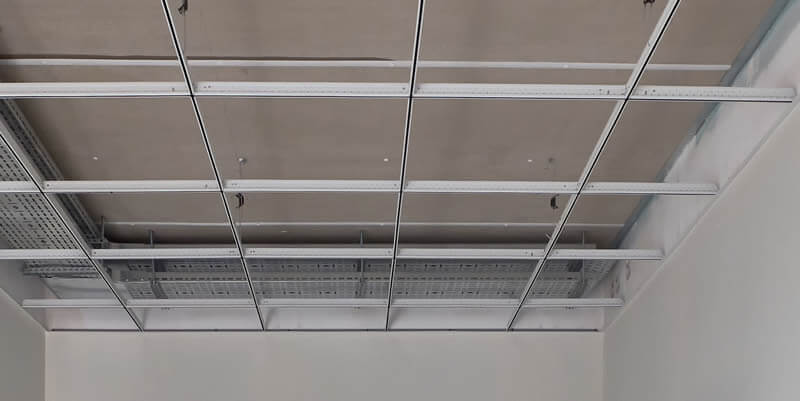Cost of Drop Ceiling Installation
The average cost to have a drop ceiling installed is right at $5.50 per square foot when you choose a local remodeling company to handle the installation. For the DIY’ers out there, you can plan to pay around $2.70 per square foot to install a drop ceiling yourself.
When hiring a local company they’ll include an initial visit to determine how many ceiling tiles and rails are needed, the type of acoustic tiles you want to have installed, as well as providing a price quote. On the day of installation they’ll perform all work and provide all materials, as well as cleaning up after the job is completed.
Average Costs
Overview of Drop Ceilings
A drop ceiling gives any room a completed look. Suspended ceiling and false ceiling are other common names for this interior home project.
Drop ceiling cost is less than drywall ceilings cost, and the project is more DIY-friendly. A false ceiling also gives you access to pipes, wiring and other mechanical features that drywall does not. This makes a suspended ceiling an ideal choice in basements.
Pro Tip: Be sure cold water pipes are insulated before installing the ceiling. Otherwise, water may condense on them and drip onto the ceiling, causing staining and mold.
Classic, inexpensive fiberboard tiles are still available. But most ceiling tiles are decorative vinyl / PVC panels and tiles in faux wood styles. Metal tiles in a variety of finishes cost a little more. Tiles 2’x2’ and 2’x4’ are most common, though a few 1’x1’ and 1’x2’ tiles are available.
This page of Costimates includes retail pricing for materials – grid rails, various panel materials and accessories – to determine DIY drop ceiling installation cost.
Labor cost per square foot is given for pro installation along with a chart to compare drop ceiling price estimates from reliable sources online. Homeowners also provide their cost to install a drop ceiling, and you’re invited to share your cost once the project is complete.
Product and Materials Cost Details
Drop Ceiling Tile Price Factors
There’s a broad cost range for drop ceilings. Here are suspended ceiling cost factors and how they impact the bottom line.
- Size of the Drop Ceiling – Obviously, the larger the area covered, the higher the cost. However, for pro installation, cost per square foot usually drops slightly as size increases.
- Panel Material – Retail costs are listed next. There is quite a range between inexpensive mineral fiber panels those with special features such as acoustic design or mold resistant panels ideal for basements.
- Panel Quality – In each material, cheap, midgrade and premium tiles are available.
- Who Does the Work – When hiring a pro, drop ceiling installation cost accounts for more than 50% of cost when cheap materials are used and about 25% when acoustic panels and decorative PVC ceiling panels are installed. Below is a discussion of whether this is a good do-it-yourself project.
- Complexity of the Work – Cost to install a drop ceiling is relatively low when the room is wide open and uncluttered. Cost rises when installers have to work around features like a furnace plenum, water heater plumbing and vent.
- Whether Lighting is Included – Our drop ceiling cost per square foot doesn’t include recessed lighting fixtures. However, retail costs for lights are included in the list below.
- Where you Live – If the cost of living is low, average or high, it will be reflected in the drop ceiling cost estimates you receive.
Retail Cost of Drop Ceiling Tiles and Supplies
This is a common DIY project, so perhaps you’d like to know the cost per square foot of materials and accessories.
Use a material and cost calculator to determine how much material you need and total pricing. Calculators have been produced by many drop ceiling brands including this one from Armstrong Ceilings.
https://www.armstrongceilings.com/residential/en-us/ceiling-project-estimator.html
Materials are available at home improvement stores and many online sellers.
- $1.50 – $2.25 per square foot | Grid Rails. Some brands, like Armstrong, sell grid material by the box with enough material for 60 to 100 square feet typically. Other brands, like USG, are sold by the piece, called main T’s and cross T’s. Use one of the drop ceiling material calculators to determine how much of each is needed for your ceiling.
- $0.55 – $0.95 per square foot | Fiberboard Drop Ceiling Tiles. Some of these are acoustic tiles designed to absorb noise and reduce echo.
- $1.75 – $4.75 per square foot | PVC and Vinyl Drop Ceiling Tiles. Cost is based on thickness of the tiles and how elaborately they are styled.
- $3.50 – $6.25 per square foot | Metal Drop Ceiling Tiles in tin, aluminum and steel. Finishes include copper, bronze and pewter in various hues plus a range of paint colors.
- $1.60 – $1.85 per square foot (Optional)| Insulation Tiles can be used above each tile. Soniguard is a popular brand that reduces noise and adds R6 insulation value to the ceiling.
- $0.75 – $1.15 per square foot | Wire, clips, anchors and other installation accessories.
- $0.45 – $0.60 per linear foot (Optional) | Decorative Vinyl Rail Covers are produced by brands like ProLITE to complement its ceiling tiles.
- $0.25 – $0.50 per linear foot (Optional)| Plastic Tape for covering the rails. It is available in many colors to match or contrast your ceiling tile color.
- $3.00 – $10.00 | Hand Tools: A utility knife and blade can be used to cut fiberboard tiles. Snips are used for vinyl/plastic/PVC and metal drop ceiling tiles.
- $20 – $50 | A good 6’ bubble level can be used (starting at $20), but a compact laser level is a better choice for precision leveling ($35 – $50).
- $85 – $170 Each | LED Panel Lights with Mounting Kits, designed for drop ceilings. Most drop ceiling light panels are 2’x2’ or 2’x4’.
- $40 – $220 Each | Recessed Light Fixtures in a range of options including single and double lights, trim packages and fixture color.
- $20 – $35 | Light Controls/Rheostats
Permits, Inspection, Related Costs and Installation Time
Permits and Inspection Cost
- $0 | No permit is required for installing a drop ceiling.
Related Costs and Installation Time
Hiring a local handyman service is a good choice if you don’t intend to DIY your drop ceiling. Some licensed contractors will also do this work. They can subcontract an electrician to install wiring, lights and controls. Those costs are not covered in this estimate.
Labor rates are higher in large metro areas especially on the Coasts. They’re lower in rural areas and small towns.
- $50 – $80 per hour | Cost to Hire a Handyman
- $70 – $135 per hour | Cost to Hire a Licensed Contractor
How long does it take to hang a drop ceiling? Knowing that will help you estimate your total drop ceiling installation cost.
Expect pros to install a suspended ceiling at the rate of 30 to 40 square feet per hour based on the complexity of the ceiling. Here’s what a 1,000 square foot job time frame might look like for one person. Two people will go a little more than twice as fast.
- Up to 3 Days | Constructing and hanging the grid network
- 4-6 Hours | Installing drop ceiling tiles
- Up to 6 Hours | Optional installation of rail tape or covers
The best time to install lighting is after the grid is in place, so the exact location of junction boxes can be determined, and before the tiles are installed.
Related Projects
When hiring a contractor to install your drop ceiling, you’ll often save money when you bundle projects together. Here are several other common projects that are related to, or done at the same time as a suspended drop ceiling installation.
Are You a Drop Ceiling Installer?
If so, head over to our Costimates Pro’s page, and help us make this page better and more accurate for both our visitors and your future customers.
DIY or Hire a Pro?
I’ve installed a drop ceiling in our basement and helped a relative on hers. The grid work is tedious but not complex or difficult.
The keys are to:
- Make sure you purchase materials that are compatible – either of the same brand or that you’re sure will work together.
- Determine whether you want partial tiles on two edges, considering the room is a rectangle (easiest), or whether you want to balance the ceiling so that there are partial edges on all sides.
- Take your time using the level to get the guide line very level around the perimeter of the room and building grid around obstructions like a furnace plenum.
- Wear gloves – the cut edges of metal rails are very sharp.
If you DIY, expect your pace to be 1.5 to 2 times what we’ve listed above for experienced pros. In other words, 15 to 25 square feet per hour.


 Steve Hansen, that's me, the Senior Editor of Costimates. (
Steve Hansen, that's me, the Senior Editor of Costimates. (